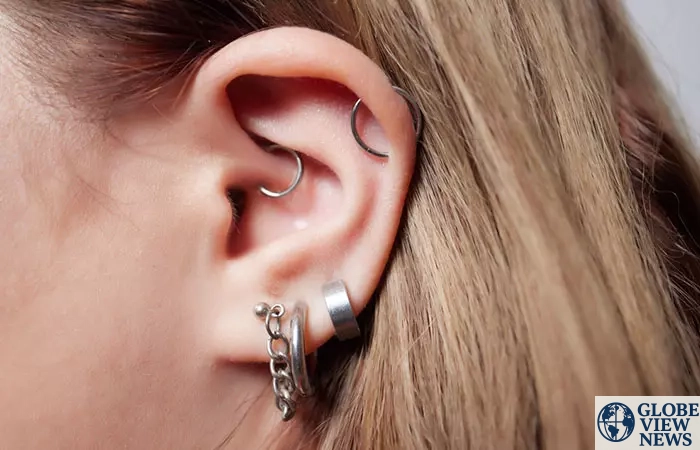Conch piercing has emerged as one of the most fashionable and sought-after ear piercings in recent years. Its unique placement in the ear’s cartilage offers an elegant yet edgy aesthetic that appeals to both minimalists and maximalists in body art. Unlike traditional lobe or helix piercings, conch piercing adds depth and dimension to ear styling, becoming a centrepiece that can be adorned with studs, hoops, or intricate cuffs to create a personalised look.
The term “conch piercing” derives from the part of the ear it is located in—the concha, which resembles the spiral shell of the same name. This area sits in the middle cartilage of the ear, offering a bold canvas for creative jewellery choices. The piercing has been part of various cultures historically, symbolising beauty, individuality, or tribal identity. Today, it is a staple in modern piercing studios worldwide, blending ancient art with contemporary fashion.
There are two primary types of piercing: inner conch and outer conch. The inner conch is pierced through the flat cartilage in the centre of the ear, close to the ear canal. It is often adorned with studs that sit neatly within the ear’s contours, creating a subtle yet distinctive statement.
The outer piercing, on the other hand, is placed on the cartilage’s outer rim but still within the conch area. This style is typically decorated with hoops that encircle the ear’s edge, giving an illusion similar to a cuff without needing additional hardware. Many people choose to combine both inner and outer cnch piercings for a layered, curated ear aesthetic.
Getting a piercing is a professional process that requires precision, sterilisation, and aftercare diligence. The procedure begins with selecting a reputable studio and experienced piercer who adheres to hygiene standards. Upon arrival, the piercer will discuss jewellery options, placement preferences, and assess your ear anatomy to determine the ideal angle and positioning.
The ear is then cleaned with an antiseptic solution to prevent infection. The piercer marks the piercing spot for approval. Conch piercing is performed using a sterilised hollow needle rather than a piercing gun, as guns can cause tissue trauma and improper healing in cartilage areas.
With steady pressure, the piercer inserts the needle through the marked area, followed by immediate placement of the selected jewellery. Some mild pain and a pressure sensation are normal during the process, but it is generally quick, taking only a few seconds to complete. The initial jewellery is usually a stud with appropriate gauge thickness to accommodate swelling and promote safe healing.
Pain perception is subjective and varies between individuals. Generally, piercing is rated moderate on the pain scale compared to lobe piercings but less painful than industrial or rook piercings. The discomfort arises due to cartilage density, causing a sharp pinch during insertion, followed by soreness for a few days.
The healing process for piercing ranges from 6 to 12 months, depending on aftercare consistency and individual healing rates. During the initial weeks, the area may feel tender, swollen, or slightly warm to touch. Redness and clear lymph discharge are normal parts of healing. However, persistent pain, yellow or green discharge, or fever require immediate medical consultation as they may indicate infection.
Proper aftercare is crucial for piercing to heal safely and retain its aesthetic appeal. The following guidelines ensure healthy healing:
Cleanse with Saline Solution: Twice daily cleaning with sterile saline solution or a saltwater soak helps keep bacteria at bay without irritating the piercing site.
Avoid Touching: Do not touch, twist, or change jewellery unnecessarily as it increases infection risk and delays healing.
Sleep Caution: Avoid sleeping on the pierced ear to prevent irritation, swelling, and migration of jewellery.
Hair and Accessories: Keep hair away from the piercing, especially during early healing, and avoid earphones or hats that cause friction.
No Swimming Initially: Pools, hot tubs, and natural bodies of water contain bacteria that may infect the new piercing.
Following these practices minimises complications and ensures your piercing heals beautifully.
Jewellery selection plays a significant role in both comfort and style. Initially, professional piercers recommend implant-grade titanium or surgical steel studs, as these hypoallergenic metals reduce the risk of irritation or allergic reaction. Once fully healed, the jewellery options expand widely to include:
Flat Back Studs: Perfect for inner conch piercings, they sit flush against the ear, offering comfort and subtlety.
Hoops: Captive bead rings or seamless hoops are popular for outer conch piercings, creating an elegant cuff-like appearance.
Clickers: Decorative clicker rings with gemstones or intricate designs offer a bold statement for special occasions.
Custom Designs: Many artisan jewellers create bespoke pieces tailored to individual ear anatomy, adding uniqueness to your piercing.
Jewellery gauge sizes vary, but professional studios typically use 16G or 14G for piercing, ensuring structural integrity while preventing migration or tearing.
While piercing is generally safe when performed professionally, potential risks include:
Infection: Due to its cartilage location, infections can spread quickly if hygiene is neglected.
Keloids and Hypertrophic Scarring: Some individuals develop raised scars due to genetic predisposition or irritation.
Migration and Rejection: Improper technique or unsuitable jewellery can lead to migration, where the piercing shifts position, or rejection, where the body pushes the jewellery out completely.
Cartilage Damage: Using piercing guns instead of needles can shatter cartilage, causing irreversible damage.
Choosing an experienced piercer and adhering strictly to aftercare reduces these risks significantly.
Historically, ear piercings held cultural, spiritual, and social meanings in various societies. In some Native American tribes, ear cartilage piercings, including piercing, were symbols of strength, tribal status, or rites of passage. In South Asian cultures, ear piercings are performed during childhood as part of religious and cultural traditions.
Today, piercing represents self-expression, confidence, and modern aesthetics. Celebrities like Rihanna and Zoe Kravitz have popularised piercing, often pairing them with multiple lobe and cartilage piercings to create curated ear stacks that inspire global trends. The rise of minimalist jewellery brands has further driven its popularity, offering dainty yet impactful designs suitable for conch placements.
Beyond physical appearance, piercing holds psychological significance. For many, getting a piercing marks a personal milestone, symbolising freedom, resilience, or transformation. The process of enduring piercing pain and caring for the healing period instils a sense of responsibility, discipline, and pride.
Furthermore, adorning oneself with unique piercings fosters individuality and confidence. Studies in body art psychology indicate that piercings often empower individuals by allowing them to reclaim agency over their bodies and self-image.
In the fashion world, piercing is embraced by designers and stylists for its versatility. Editorial shoots often feature models with stacked ear piercings, showcasing conch jewellery as a focal point to elevate the overall look. From sleek minimalist studs to gemstone-encrusted hoops, conch piercings adapt seamlessly to diverse fashion aesthetics, including streetwear, boho-chic, and high couture.
Jewellery brands have dedicated entire collections to cartilage piercings, with piercing pieces ranging from affordable stainless steel designs to luxury 18K gold and diamond adornments. This universal adaptability cements conch piercing’s place as a permanent feature in fashion and personal styling.
As piercing artistry continues to evolve, future trends in piercing include:
Stacked Conch Piercings: Multiple piercings along the cartilage for layered jewellery styling.
Chain Attachments: Decorative chains connecting conch piercings to other ear piercings, creating a cohesive ear tapestry.
Coloured Titanium Jewellery: Rainbow anodised titanium pieces for bold, futuristic aesthetics.
Hybrid Piercings: Combining conch with rook or daith piercings for creative placement patterns.
These innovations indicate that conch piercing will remain a dynamic canvas for creativity in body art.
In conclusion, piercing is more than a passing trend. It is an ancient art reborn into modern beauty and fashion culture, offering individuals a powerful means of self-expression, style elevation, and personal symbolism. Its versatility accommodates subtle elegance for corporate environments and dramatic statement pieces for events, making it suitable for every personality.
Understanding the procedure, choosing the right studio and jewellery, and committing to diligent aftercare are essential to enjoying a safe, beautiful piercing. Whether you seek to celebrate individuality, mark a personal milestone, or simply enhance your ear styling, piercing remains an empowering choice that embodies both tradition and modernity.
Ultimately, the beauty of piercing lies not only in its aesthetic impact but also in the journey it represents – a journey of embracing discomfort for the sake of art, learning responsibility through aftercare, and adorning oneself in ways that reflect inner strength, creativity, and authenticity.

